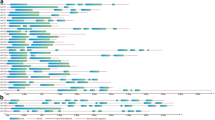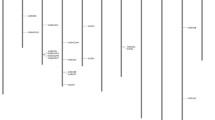Abstract
Cysteine protease activity comprises the majority of proteolytic activities in plants. They are involved in almost every facet of the plant’s development. Accumulating evidence indicates multiple roles of this protease type in response to biotic and abiotic stress. To understand the regulations and functions of cysteine protease in rice, its evolutionary and structural evidence was uncovered in this study. Using MEROPS, a peptidase database, the 74 rice cysteine proteases belonging to six families were queried. Each of these families represents distinct proteolytic enzyme; C1 is a papain-like protease, C2 is a calpain-2-type, C12 is an ubiquitinyl hydrolase-L1 enzyme, C13 is legumain, C14 is a caspase-1 type, and C15 is a pyroglutamyl peptidase 1 enzyme type. Evolutionary expansion attributed to gene duplication and diversification was particularly evident in C1 family which showed the highest number (n = 53) of members, most of which contained the highest number and most variable introns and motifs, whereas families C13, C14, and C15 had only a few members which all contained lesser number and variation of intron and motif. Out of 74 total cysteine protease gene members, 73 were globular proteins and 55 were predicted as stable proteins. Spatial expression assay of selected C1 members showed that LOC_Os01g73980 and LOC_Os05g01810 were highly expressed in the stem and leaves, while LOC_Os02g27030 was constitutively expressed in all tissues. The expression of LOC_Os01g73980 and LOC_Os05g01810 was also highly activated by salinity stress, while LOC_Os02g27030 was activated by both salinity and heat. LOC_Os05g01810 overexpression transgenic rice exhibited moderate tolerance to salinity stress, which provides interesting clues on biological functions of these genes in rice.









Similar content being viewed by others
References
Amit M, Donyo M, Hollander D, Goren A, Kim E, Gelfman S, Lev-Maor G, Burstein D, Schwartz S, Postolsky B, Pupko T, Ast G (2012) Differential GC content between exons and introns establishes distinct strategies of splice-site recognition. Cell Rep 1(5):543–556
Atsushi I (1980) Thermostability and aliphatic index of globular proteins. J Biochem 88:1895–1898
Bailey TL, Elkan C (1994) Fitting a mixture model by expectation maximization to discover motifs in biopolymers. Proc Int Conf Intell Syst Mol Biol 2:28–36
Beynon R, Bond JS (2000) Proteolytic enzymes, 2nd edn. Series Practical Approach. Oxford University Press, Oxford
Carels N, Bernardi G (2000) Two classes of genes in plants. Genetics 154(4):1819–1825
Chen JM, Fortunato M, Barrett AJ (2000) Activation of human prolegumain by cleavage at a C-terminal asparagine residue. Biochem J 352:327–334
Chen JM, Dando PM, Barrett AJ (2004) Mammalian legumain. In: Barrett AJ, Rawlings ND, Woessner JF (eds) Handbook of proteolytic enzymes, 2nd edn. Elsevier, London, pp 1302–1305
Choudhuri S (2014) Bioinformatics for beginners: genes, genomes, molecular evolution, databases and analytical tools. Academic Press, New York. ISBN 978-0-12-410471-6
Clement Y, Fustier M-A, Nabholz B, Glemin S (2015) The bimodal distribution of genic GC content is ancestral to monocot species. Genome Biol Evol 7(1):336–348
Dando PM, Fortunato M, Strand GB, Smith TS, Barrett AJ (2003) Pyroglutamyl-peptidase I: cloning, sequencing, and characterization of the recombinant human enzyme. Protein Expr Purif 28:111–119
Earnshaw WC, Martins LM, Kaufmann SH (1999) Mammalian caspases: structure, activation, substrates, and functions during apoptosis. Annu Rev Biochem 68:383–424
Goodall GJ, Filipowicz W (1989) The AU-rich sequences present in the introns of plant nuclear pre-mRNAs are required for splicing. Cell 58(3):473–483
Goodall GJ, Filipowicz W (1991) Different effects of intron nucleotide composition and secondary structure on pre-mRNA splicing in monocot and dicot plants. EMBO J 10(9):2635–2644
Grudkowska M, Zagdanska B (2004) Multifunctional role of plant cysteine proteinases. Acta Biochim Pol 51:609–624
Hayashi Y, Yamada K, Shimada T, Matsushima R, Nishizawa NK, Nishimura M, Hara-Nishimura I (2001) A proteinase-storing body that prepares for cell death or stresses in the epidermal cells of Arabidopsis. Plant Cell Physiol 42:894–899
Hemelaar J, Borodovsky A, Kessler BM, Reverter D, CookJ Kolli N, Gan-Erdene T, Wilkinson KD, Gill G, Lima CD, Ploegh HL, Ovaa H (2004) Specific and covalent targeting of conjugating and deconjugating enzymes of ubiquitin-like proteins. Mol Cell Biol 24:84–95
Higo K, Ugawa Y, Iwamoto M, Korenaga T (1999) Plant cis-acting regulatory DNA elements (PLACE) database. Nucleic Acids Res 27:297–300
Jain M, Khurana P, Tyagi AK, Khurana JP (2008) Genome-wide analysis of intronless genes in rice and Arabidopsis. Funct Integr Genom 8:69–78
Johnston SC, Riddle SM, Cohen RE, Hill CP (1999) Structural basis for the specificity of ubiquitin C-terminal hydrolases. EMBO J 18:3877–3887
Jones JT, Mullet JE (1995) A salat and dehydration-inducible pea gene, Cyp15a, encodes a cell-wall protein with sequence similarity to cysteine protease. Plant Mol Biol 28:1055–1065
Karrer KM, Peiffer SL, Ditomas ME (1993) Two distinct gene subfamilies within the family of cysteine protease genes. Proc Natl Acad Sci USA 90:3063–3067
Koizumi M, Yamaguchi-Shinozaki K, Tsuji H, Shinozaki K (1993) Structure and expression of two genes that encode distinct drought-inducible cysteine proteinases in Arabidopsis thaliana. Gene 129:175–182
Kumar S, Stecher G, Tamura K (2016) MEGA7: molecular evolutionary genetics analysis version 7.0 for bigger datasets. Mol Biol Evol 33:1870–1874
Liu Z, Chen S, Xie L, Lu Z, Liu M, Han X, Qiao G, Jiang J, Zhuo R, Qiu Q, He Z (2017) Overexpression of cysteine protease gene from Salix matsudana enhances salt tolerance in transgenic Arabidopsis. Environ Exp Bot 147:53–62
Lodish H, Berk A, Zipursky SL (2000) Molecular cell biology, 4th edn. W. H. Freeman, New York
Lu Y, Song Z, Lu K, Lian X, Cai H (2012) Molecular characterization, expression and functional analysis of the amino acid transporter gene family (OsAATs) in rice. Acta Physiol Plant 34:1943–1962
Niño MC, Kim JK, Lee HJ, Abdula SE, Nou IS, Cho YG (2014) Key roles of cysteine protease in different plant pathosystem. Plant Breed Biotech 2(2):97–109
Niño MC, Nogoy FM, Kang KK, Cho YG (2018) Low-affinity cation transporter 1 improves salt stress tolerance in Japonica rice. Plant Breed Biotech 6(1):82–93
Parsell DA, Sauer RT (1989) The structural stability of a protein is an important determinant of its proteolytic susceptibility in Escherichia coli. J Biol Chem 264(13):7590–7595
Rawlings ND, Morton FR, Barrett AJ (2006) MEROPS: the peptidase database. Nucl Acids Res 34:270–272
Rawlings ND, Barrett AJ, Bateman A (2010) MEROPS: the peptidase database. Nucl Acids Res 38:227–233
Rawlings ND, Waller M, Barrett AJ, Bateman A (2014) MEROPS: the database of proteolytic enzymes, their substrates, and inhibitors. Nucl Acids Res 42:503–509
Ressayre A, Glemin S, Montalent P, Serre-Giardi L, Dillmann C, Joets J (2015) Introns structure patterns of variation in nucleotide composition in Arabidospsis thaliana and rice protein-coding genes. Genome Biol Evol 7(10):2913–2928
RStudio Team (2015) RStudio: integrated development for R. RStudio, Inc., Boston, MA, http://www.rstudio.com
Saitou N, Nei M (1987) The neighbor-joining method: a new method for reconstructing phylogenetic trees. Mol Biol Evol 4(4):406–425
Sato K, Saito Y, Kawashima S (1995) Identification and characterization of membrane-bound calpains in clathrin-coated vesicles from bovine brain Eur. J Biochem 230:25–31
Shabalina SA, Spiridonov NA, Kashina A (2013) Sounds of silence: synonymous nucleotides as a key to biological regulation and complexity. Nucl Acids Res 41(4):2073–2094
Shindo T, van der Hoorn RAL (2008) Papain-like cysteine proteases: key players at molecular battlefields employed by both plants and their invaders. Mol Plant Pathol 9:119–125
Sorimachi H (2004) Mu-Calpain. In: Barrett AJ, Rawlings ND, Woessner JF (eds) Handbook of Proteolytic Enzymes, 2nd edn. Elsevier, London, pp 1206–1211
Thompson JD, Gibson TJ, Plewniak F, Jeanmougin F, Higgins DG (1997) The CLUSTAL_X windows interface: flexible strategies for multiple sequence alignment aided by quality analysis tools. Nucl Acids Res 25:4876–4882
Travaglini-Allocatelli C, Ivarsson Y, Jemth P, Gianni S (2009) Folding and stability of globular proteins and implications for function. Curr Opin Struct Biol 19(1):3–7
van der Hoorn RAL, Leeuwenburgh MA, Bogyo M, Joosten MHAJ, Peck SC (2004) Activity profiling of papain-like cysteine proteases in plants. Plant Physiol 135:1170–1178
Wang C, Barry JK, Min Z, Tordsen G, Rao AG, Olsen OA (2003) The calpain domain of the maize DEK1 protein contains the conserved catalytic triad and functions as a cysteine proteinase. J Biol Chem 278:34467–34474
Wang D, Pei K, Fu Y, Sun Z, Li S, Liu H, Tang K, Han B, Tao Y (2007) Genome-wide analysis of the auxin response factors ARF gene family in rice Oryza sativa. Gene 394:13–24
Warnecke T, Weber CC, Hurst LD (2009) Why there is more to protein evolution than protein function: splicing, nucleosomes and dual-coding sequence. Biochem Soc Trans 37:756–761
Weatheritt RJ, Babu MM (2013) The hidden codes that shape protein evolution. Science 342(6164):1325–1326
Wilkinson KD, Laleli-Sahin E, Urbauer J, Larsen CN, Shih GH, Haas AL, Walsh ST, Wand AJ (1999) The binding site for UCH-L3 on ubiquitin: mutagenesis and NMR studies on the complex between ubiquitin and UCH-L3. J Mol Biol 291:1067–1077
Yamaguchi-Shinozaki K, Koizumi M, Urao S, Shinozaki K (1992) Molecular cloning and characterization of 9 cDNAs for genes that are responsive to desiccation in Arabidopsis thaliana: sequence analysis of one cDNA clone that encodes a putative transmembrane channel protein. Plant Cell Physiol 33:217–224
Acknowledgements
This research was supported by the Next-Generation BioGreen 21 Program (The Agricultural Genome Center, No. PJ01330201), Rural Development Administration, and by the Korea Institute of Planning and Evaluation for Technology in Food, Agriculture, Forestry and Fisheries (IPET) through Golden Seed Project funded by the Ministry of Agriculture, Food and Rural Affairs (MAFRA) (213009-05-3-WT211), Republic of Korea.
Author information
Authors and Affiliations
Corresponding authors
Ethics declarations
Conflict of interest
The authors declare no conflict of interest.
Additional information
Publisher's Note
Springer Nature remains neutral with regard to jurisdictional claims in published maps and institutional affiliations.
Electronic supplementary material
Below is the link to the electronic supplementary material.
Rights and permissions
About this article
Cite this article
Niño, M.C., Kim, MS., Kang, K.K. et al. Genome-wide identification and molecular characterization of cysteine protease genes in rice. Plant Biotechnol Rep 14, 69–87 (2020). https://doi.org/10.1007/s11816-019-00583-8
Received:
Accepted:
Published:
Issue Date:
DOI: https://doi.org/10.1007/s11816-019-00583-8




